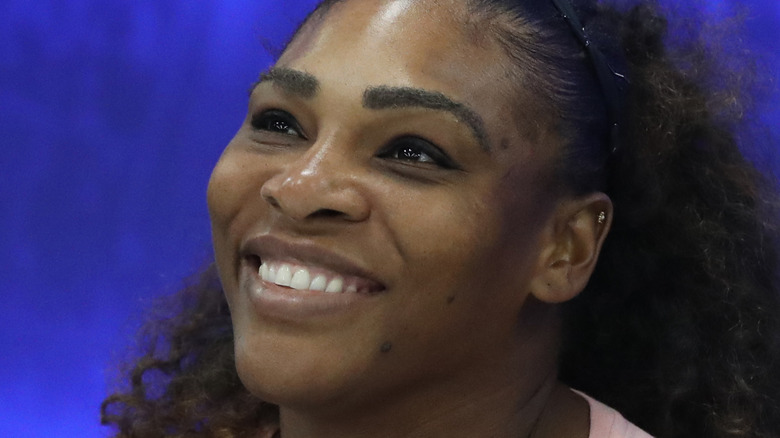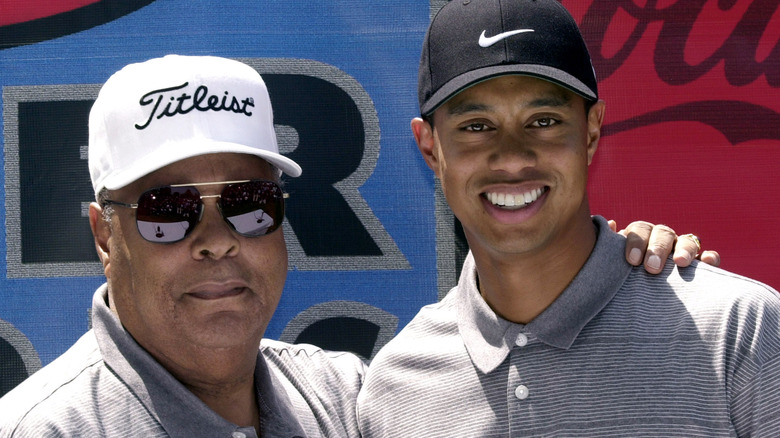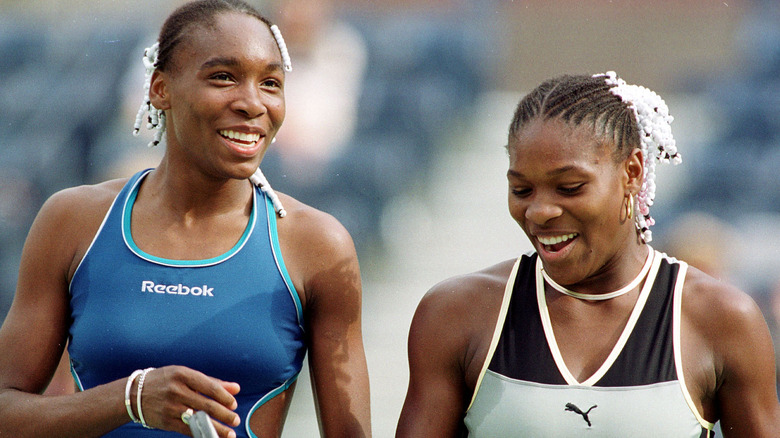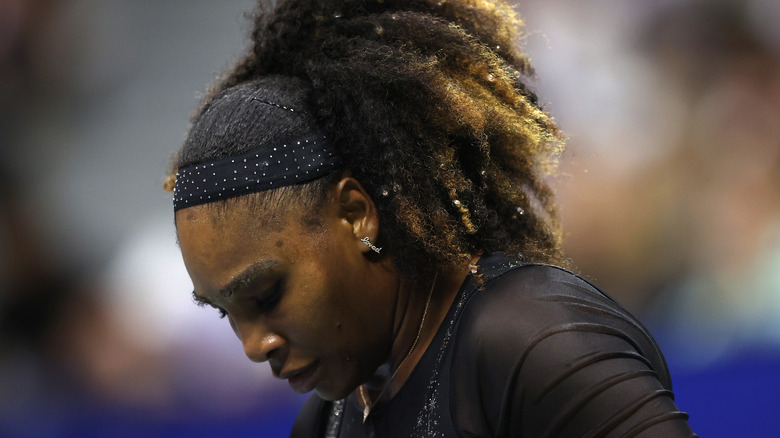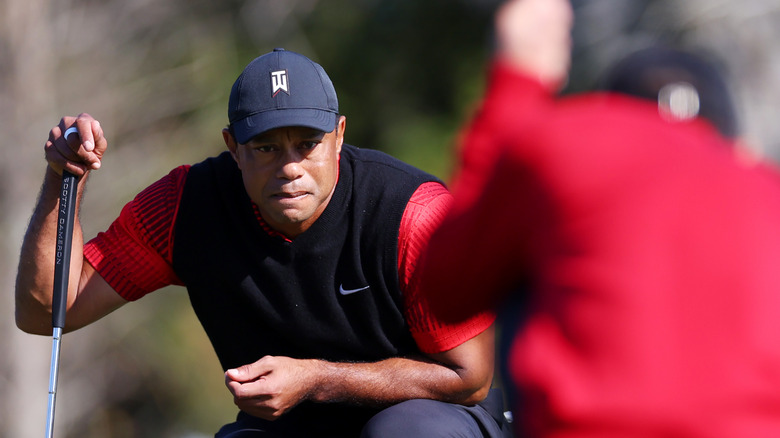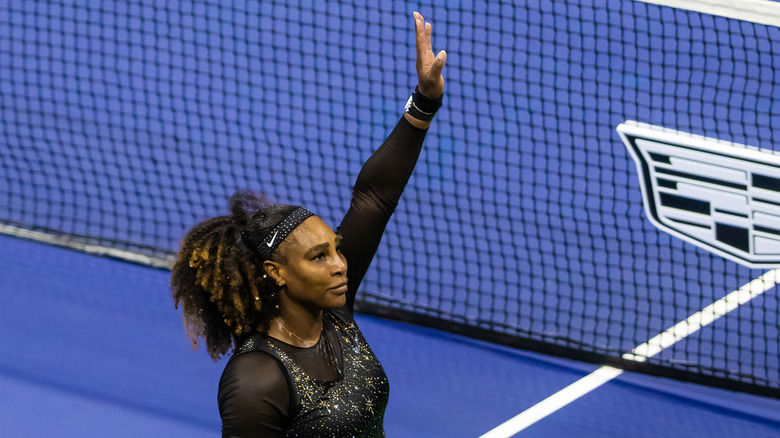Tiger Woods And Serena Williams' Mirrored Lives Produced A Close Friendship
Friendships among athletes in their own sports are common, if not expected. But when an athlete reaches across to another sport, it's because there's a special level of respect or commonality that inspires them to connect with somebody they won't see in the locker room. In the case of Serena Williams and Tiger Woods, it was mutual admiration and similar life experiences that led the two into a close friendship that has lasted for many years. The two have been cheering in the stands for the other's biggest moments, and they have offered support during some of the others' most challenging times. Woods considers Williams one of his most trusted confidants. "We're very close friends," he told The New York Times, noting they've often helped each other through difficult times.
However, for Williams, it wasn't obvious they would have a friendship when they first met. She was too blown away by the sheer superstar quality of the golf legend to even think about becoming friends with him. "When I first met Tiger, I honestly didn't think we would be friends. I was just honestly in awe of him, like he is Tiger Woods, he was competing against everyone and he looked like me," she said in a PGA Tour video (via YouTube). "One thing I admired the most about Tiger is his mental strength and his ability to win. Win on one leg or win when you are feeling awful. That's a real champion."
Products of willful fathers
Tiger Woods might be six years older than Serena Williams, but the two share parallels in their upbringings. Both had strong father figures who introduced them to their respective sports at a young age, and both fathers believed their children would dominate their sports and beyond.
When Tiger was just 2 years old, Earl Woods was already helping young Tiger find his way to the putting green, even appearing on TV as a child prodigy, per Golf.com. Soon after, Tiger was winning junior golf tournaments before turning pro in 1996 at the age of 20 (via People). His greatness was obvious, and Earl Woods assigned an almost messianic quality to it. "He's the bridge between the East and the West," Earl Woods told Sports Illustrated the same year. "I don't know yet exactly what form this will take. But he is the Chosen One. He'll have the power to impact nations. Not people. Nations."
Richard Williams went so far as to hide his wife's birth control pills to force two more daughters into existence so he could raise them as tennis champions away from the public eye (per Time). Still, per The Baltimore Sun, he would tell all that the two would be the best players to ever play the game — and that they would retire after a few years on the pro tour. The millions they would rake in were meant to fund their education so they could do bigger and better things.
Playing a traditionally white sport
When Serena Williams was coming up in the pro ranks in the 1990s, she had her older sister Venus to clear a path for her. But the truth is, both were met with a skeptical eye for their unconventional route into a predominantly white sport where class issues also divided people. "I definitely was scrutinized because I was confident. I was Black and I was confident. And I am Black. I am confident," she told ESPN (via People). Taking that strong of a stance was not appreciated, Williams said. She added: "We literally took the globe and shook it, me and Venus. Because we came from Compton. We came from nothing. In tennis you kind of have to have something."
For Tiger Woods, the question of race in a primarily white sport was even more complicated. He launched his career at a time when there were still clubs in the U.S. that would not allow him on their golf courses because he was not white. Before he turned pro in 1996, Woods learned it was important to own his multiracial background as a preemptive strike. He called himself "Cablinasian" — made up of Caucasian, black, Indian, and Asian. Nike made his multiracial background the center of an ad campaign, simultaneously calling out racial barriers in golf culture. According to Sports Illustrated, some didn't appreciate the scrutiny. He later told Oprah (via the Independent), "I'm just who I am, whoever you see in front of you."
A support system during difficult times
In 2018, both Serena Williams and Tiger Woods were on the comeback trail following serious health issues. Per Golf Digest, Woods had undergone a spinal fusion in 2017, and Williams nearly died giving birth to her daughter Olympia that same year, according to Vogue. Williams' reentry to the tour was anything but easy, including a few injuries that hampered her progress. Still, she made her way to the finals of Wimbledon in July 2018, which Woods watched from her player's box at the All England Lawn Tennis Club. "We've talked at length," Woods told The New York Times, adding, "I think we both have had some nice comebacks this year."
For his part, Woods was just starting to walk again following his 2017 surgery. He bounced back from self-doubt and a prescription drug addiction to ease his back pain, which led to a DUI, per ESPN. So swinging a golf club again and competing at the highest level was something of a miracle that inspired Williams. "He's been coming back from all his back issues. It's been a disaster. But, boy, he never gave up. It's inspiring, actually. I don't think a lot of people really know how bad it was," she said during a press conference (via the WTA Tour). "But it definitely makes me realize that, okay ... I can definitely do my best if he can, too."
Unmatched drive
Tiger Woods' fellow pro golfer Rory McIlroy believes Serena Williams and Woods keep going under difficult conditions because they don't want to let people down. "You get what you give, and I think Tiger and Serena over the years have given people so much joy by playing their sport the best they can. They want to be able to keep doing that, but it's hard. Time catches up," McIlroy told The New York Times. He added: "Serena and Tiger didn't show any vulnerability for 20 years. Now people see that side of them and it humanizes them and it makes them more endearing."
In 2022, Williams said it was Woods' encouragement that helped her make a push that year when it seemed like her career could be over. "He's one of the reasons I'm here, one of the main reasons I'm still playing," she told People. "He was really trying to get me motivated. There's a few people, but we were like, 'Okay, we can do this together,' you know?" Williams said she felt confused, but Woods helped her get direction. "When you can rely on someone like that, I mean — my goodness, he's Tiger Woods — it was really helpful to get clarity." Woods saw it all the way through, cheering Williams on from the stands at the 2022 U.S. Open and expressing pride in his friend. "It was a privilege to watch greatness. Congrats @serenawilliams," he posted on Twitter.
Williams and Woods in the twilight of their careers
For any athlete, knowing when to retire is a difficult question to answer. That's even more true when you've been at the top of your sport like Serena Williams and Tiger Woods. In August 2022, at the age of 40, Williams said her time had come, but she refused to say she was retiring. "I have never liked the word retirement," Williams said in an as-told-to piece for Vogue, later adding, "I'm here to tell you that I'm evolving away from tennis, toward other things that are important to me." Many people believed that to mean she would be done after the 2022 U.S. Open, but she's since teased the possibility of a return to the court. "I mean, you never know," Williams said on "Good Morning America" (via Yahoo! News), adding, "I've just been saying that I think Tom Brady started a really cool trend."
In December 2022, Woods was pressed on his retirement plans as he approached his 47th birthday, but he was adamant he wasn't nearing retirement, even if he couldn't meet the demands of the pro tour. "Who? Me, retire? No, no, no, no. I'm not retiring," Woods told Sky Sports. By Woods' estimation, he could have as much as eight years left in his pro golf career, but not full-time and probably not at his peak performance levels. "[T]hat's just my reality," he told Sky Sports. "I don't like it, but I just have to accept it."
